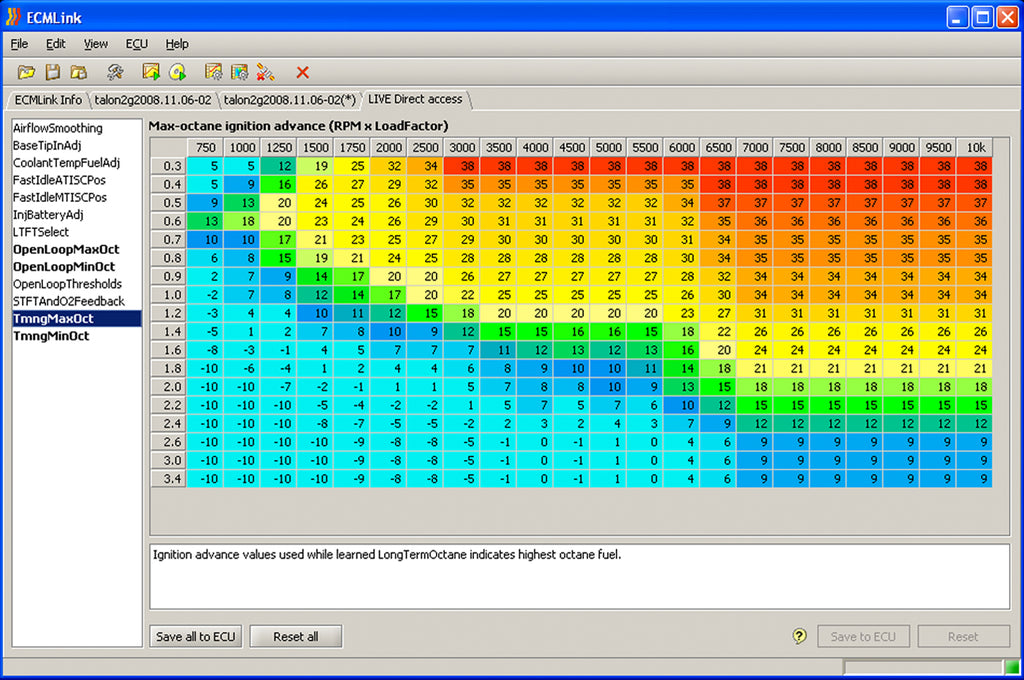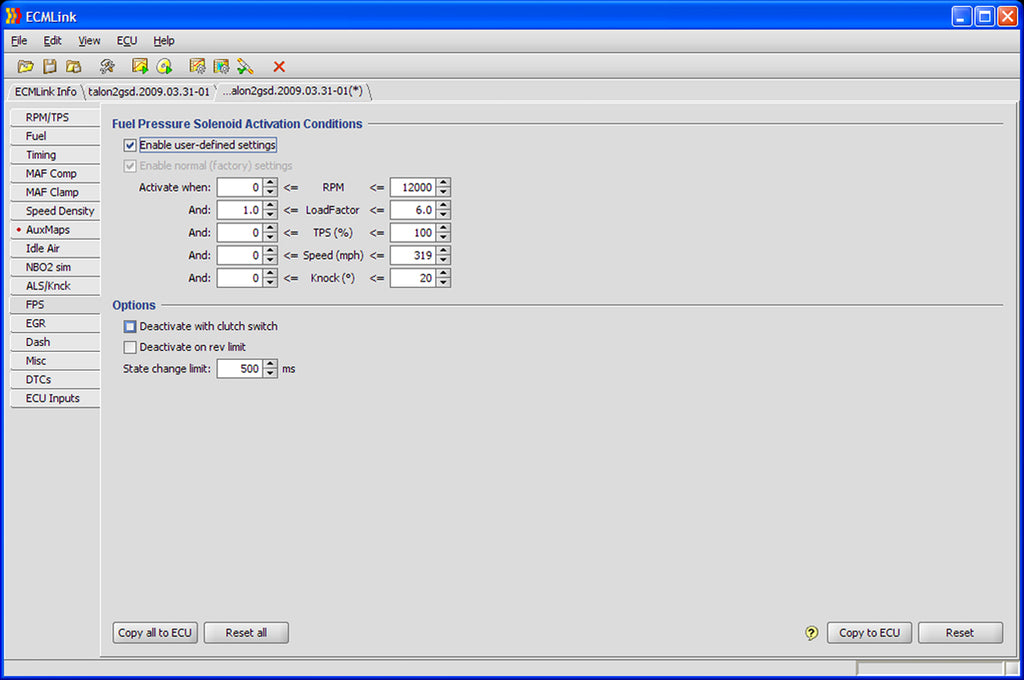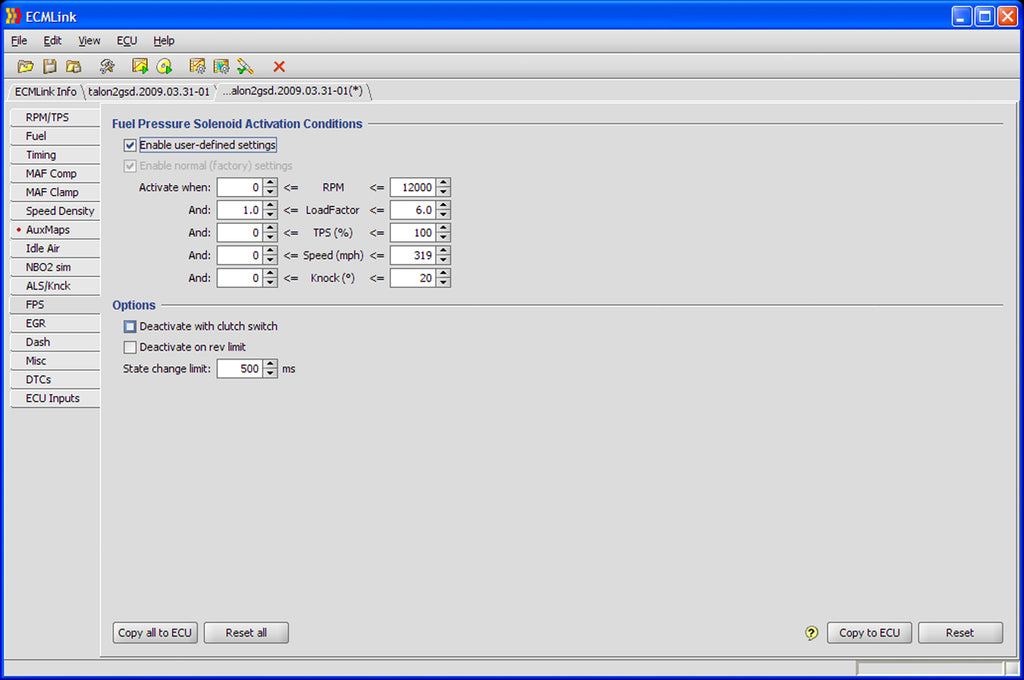ECMLink (DSM Link) V3 for 2G DSM (95-97)
ECMLink, also known as DSM Link, is a tuning and logging tool for the 1995-1997 2G DSM. ECMLink provides enhanced logging functionality and all the tuning tools you need to run any number of different configurations from bone stock cars on a stock MAF to 11-second road course beasts on speed density to 8-second drag cars.
Vehicle Fitment:
1995-1997 Eclipse GST/GSX
1995-1997 Talon TSi
Order Notes:
• Select your injectors/MAF or leave a note on your order what you have.
• GM MAF parts are currently unavailable, so we (at STM) are not offering them.
• If you need socketing or conversion services, you will need to ship your ECU in to ECMLink.
• The ECMLink team is working through COVID, but please give them time to calibrate and package your kit.
Purchase Includes:
• ECMLink CD
• USB Cable
• ECU Chip
• Additional Wiring
• Optional ECU Socketing/Conversion (Ship your ECU to ECMLink)
ECMLink V3 Features:
• Drop in Flash
• Direct Access
• Enhanced Datalogging
• Dual Bank Injectors
• Full-time Speed Density
• All-in-one datalogging, real-time tuning and reflashing package
• Extended load and RPM
Order Selections:
The settings you select when placing your order are used to provide an initial configuration in your flash module when ECMLink prepares it for you. You can definitely change all these settings yourself at any time, including injector compensation and MAF type or switch to speed density, etc, etc.
Socket / Conversion Services:
• First, check to see if your ECU needs to be socketed.
• If you need to send the EPROM ECU to be socketed, then be sure to select the Socket EPROM ECU option.
• If you need to convert your non-EPROM (1990-1997) ECU to EPROM, then select the Non-EPROM Conversion option.

Read more: ECMLink Socket Info
If you need to have these services done, ship your ECU to:
ECMTuning, Inc.
1519 W Patrick St A10
Frederick, MD 21702
(* Please put a piece of tape on the ECU with your name and contact info! *)
Speed Density (SD) Note:
If you plan to run speed density instead of a mass airflow sensor, you'll need to select "Stock MAF" as your MAF Type and then simply configure the ECU yourself when you get it installed in your car.
Instructions on configuring speed density can be found on the ECMLink Speed Density Setup Page.
To keep the order form from getting any more complicated, we have chosen to leave speed density off the list because that selection requires even more information (which MAP sensor you have installed and on which ECU input, which varies depending on ECU, etc.).
ECMLink (V3) System Requirements:
Windows 2000/XP/Vista: Our recommended configuration would be Windows XP with 256 meg of RAM. You're certainly not going to have any problems with that setup or anything better. ECMLink works fine with Vista and Windows 2000 as well. And, of course, more memory is always better. But the basic XP w/ 256meg of RAM would work very well for you.
Read More: ECMLink (V3) System Requirements
More from ECMLink:
ECMLink (V3) is an all-in-one datalogging, real-time tuning, and reflashing package for your 1990-1999 DSM. On this page you'll find a quick high-level summary of the major features in ECMLink. If you need more details, feel free to contact us and we'll try to answer everything we can. If you just want to browse through the screens, you can hit the screenshots page. We also have a number of application demo videos too.
New Application Design:
ECMLink is a huge departure from our original and very successful DSMLink package. Only a tiny portion of the old V2 application and EPROM code was used in ECMLink. It was quite literally a complete rewrite of everything to produce a better end-product. Part of that was a completely new laptop application. This was coded from ground up to produce a much more powerful, flexible, extensible, and easier to use application. Screenshots will follow in other sections, but the highlights include a multi-tab interface that allows the user to review multiple datalogs at the same time. Lining two datalogs up and then quickly switching back and forth between the two tabs is an awesome way to detect minor differences between the two that might other wise have been nearly impossible.
The design also allows the user to make adjustments to configuration settings and direct access tables without being physically connected to the car. If the user needs even more editing or viewing options, most table data can be directly copied and pasted between the ECMLink application and Excel.
Native USB Cables:
The standard datalogging cables for both the 1G and 2G platforms are now native USB interfaces. These use our own in-house designs. They're rugged and designed with years of experience behind them. They're fully opto-isolated and neither requires power from the car. They should connect more easily than the V2 cables and should prove to be even more reliable.
Drop-In Flash:
The 1G version of the V2 product included a memory board that not only added much needed additional RAM to the 1G platform but also provided a persistent storage solution. Changes made by the user to the configuration of the ECU were saved permanently in non-volatile RAM.
ECMLink V3 takes this a step further with an integrated, drop-in flash device for both 1G and 2G DSMs as well as EVO1-3 ECUs. This device not only provides persistent storage of user configuration changes to the ECU, but it also provides direct reflash access to all the factory code & table areas as well!!
This is one of the more innovative solutions I've ever seen. I'm biased, of course, but seriously, I've never seen anything this compact and easy to use for any other platform out there. It's literally the size of a standard EPROM chip, but includes SOOOO MUCH more functionality.
Direct Access:
The term “direct access” in ECMLink refers to the ability to directly manipulate table data anywhere in “code space”. This includes tweaking all the fuel and timing tables as well as various airflow tables and even how the ECU selects which fuel trim value to update!
Basically just about anything that controls ECU operation can be adjusted to meet the needs of the user's specific setup. The following picture shows one such table. This particular table is the primary ignition advance table. The values in this table are actually pulled from a stock 2003 EVO8.
Sharing complete timing and fuel data between platforms has never been so easy. Other sample files you can try out are listed on our V3 Configurations page.
Extended Load and RPM:
The previous screen shot of the direct access table actually illustrates another new V3 feature. The load and RPM indices into that table have been extended substantially over the factory defined limits. You can adjust out to 10,000 RPM and up to a load factor of 3.4. Load factor is a number you'll need to learn over time from your datalogs. But this is easily enough to cover adjustments from idle and light cruise all the way to nearly 40psi. Above the upper limits, the values defined at those limits are simply used.
Enhanced Datalogging:
V3 includes even FASTER datalogging rates than were available in V2. The datalog viewer, of course, is also significantly enhanced. The screen shot below shows a capture of over 1000 samples per second!
GM MAF Integration:
** NOTE - GM MAF CABLES ARE CURRENTLY UNAVAILABLE TO PURCHASE NEW **
You no longer need a GM MAF translator to run a GM MAF with a DSM ECU. We have included our own translation function inside the ECU itself. You simply select which GM MAF you have on your car, connect our cable between the GM MAF and the car's MAF harness and you're set. Our cable also includes break out connections for the unused intake air temp and baro pressure inputs on the factory connector. You can use these to easily connect up your own sensors in their place.
NOTE 1: I absolutely must make mention of the fact that GM MAF outputs WILL vary from car to car. Most variations should be minor and easily corrected. However, it's not at ALL unusual to see a GM MAF installation require up to 30 or 40% adjustment from our base configuration! It's simply the way the GM MAF works. If you vary the size of the piping around the GM MAF, its output is going to vary accordingly. Our test platform used a 2.5“ IC pipe with flared ends to 3” just before/after the GM MAF install point which was about 6 to 8 linear inches from the throttle body. If your setup varies from this, you can probably expect variations in GM MAF output from the base values we provide in ECMLink. There's a MAF adjustment function provided in the ECMLink application to help with this.
NOTE 2: Using a GM MAF in the upper IC of a turbo charged car is inconsistent with the design of the GM MAF *and* it's inconsistent with MANY assumptions inside the DSM ECU. Factory DSM ECU code assumes the MAF is locate way out in front of the turbo and it assumes a LOT about the characteristics of the factory Mitsubishi MAF (response times, smoothing factors, etc.). You can still use a GM MAF and you can locate it in the upper IC. It works fine and has for years. Just please be aware of the limitation and expectations. ECMLink does provide a number of direct access adjustments to many of the tables that drive the ECU's assumption about MAF behavior. So you can tweak much of this difference out.
Full-Time Speed Density:
Running full-time speed density mode is one of the many cool new V3 features. You basically run the car off an airflow estimation from manifold pressure (boost) instead of a mass air sensor. It's hard to go into detail on speed density operation in a small summary paragraph. So we'll leave the details to the following pages.
• Basic, high-level SD operation details
• Details on setting up ECMLink for SD operation
• Dial in the VE table while running off a mass airflow sensor
• Dial in the closed-loop parts of the VE table while running SD (uses fuel trim data)
Dual-Bank Injectors:
If you've wanted to run more than 4 injectors, here you go. You basically configure a set of conditions to trigger the mode and then configure how fuel should be adjusted when the mode is active. You can even dial in a delay between when the mode is technically triggered and when the adjustments actually go active. This can help with installations that use a mechanical relay, for example, to activate the secondary injector bank inputs to their injector driver box.

Additional Features:
There are numerous other new firmware features, including:
• Idle-air clamp to reduce the effect of abnormally-high airflow readings at throttle-lift (vented BOV or stalling coming to a stop when you press the clutch pedal in)
• Narrowband O2 simulation from a wideband O2 input signal (only one ECU input is required for both WB logging and normal closed-loop NB operation)
• Additional MAF-compensation frequency points
• Extended VE table for Fake MAF operation
• Integrated EVO-8 base MAF support
• Full windowed-parameter sets for output activation (Example shot)
• Secondary maps are complete copies of your fuel and timing maps that you can switch between at any time.
• Increased flexibility on the choice of ECU analog input for an aftermarket sensor (e.g. the MAP sensor is no longer limited to the MDP or EGR Temp sensor input when used with the Fake MAF)
In addition to having a multi-tab interface, the PC application has many other new features, some of which are mentioned here. Measurement units are selectable, so it's easy to switch between Imperial and Metric units, as well as absolute and gauge pressure, and lambda and air/fuel ratio. Each displayed item has an individually-adjustable display range, allowing the graph to be scaled to display the details of interest. Auto-scan, auto-connection and connection polling allows rapid connection to the ECU, making initial installation a simple task.
Future Features:
The V3 flash device is also firmware upgradeable! So as we add new features (there are several planned already), you can simply download the upgrade off our website and reprogram your device yourself. Just submit a firmware request file to us that includes all your current custom settings and we'll produce a firmware upgrade specifically for your device in your car!
Discounts:
We are sorry, discounts and codes are not available for ECMLink Products.

 |
WARNING: Cancer and Reproductive Harm www.p65warnings.ca.gov |







